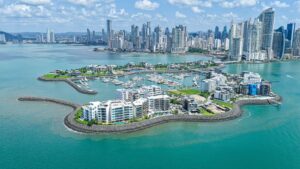Wednesday, April 7, 2021
 Dear Your Overseas Dream Home Reader,
Dear Your Overseas Dream Home Reader,
Trends are important in real estate…
As an investor, I profit from understanding trends and pre-empting them—identifying new areas of growth and getting out ahead.
I’m not talking about flash-in-the-pan fashions, like the latest craze in interior design. (Those change every other week.) I’m talking about macro trends that often take years to play out, but which can be incredibly profitable to investors who spot them early.
These are trends that stem from great societal shifts, macro-economic growth, or geopolitics. Trends that, once identified, can be used to set yourself up for years of profit with the right real estate plays.
For instance, we followed the huge transformation of the Riviera Maya, and the Path of Progress that turned Tulum from a small vishing village into a booming beach destination… We’ve profited from Panama’s emergence as a global hub… And we’ve played the mass tourism trend on Spain’s Costa del Sol.
Tomorrow, I’ll be discussing how one such trend is creating an opportunity in the South of France.
Today, however, I’m handing you back to my senior researcher, Margaret Summerfield.
Margaret is in Cannes on France’s iconic Riviera, looking for a new base in southern Europe.
Cannes is a city where the contemporary meets the historic…where glitzy cosmopolitanism and the old French way of life converge… And where some of the trends of yesteryear are still alive and kicking on its narrow street…
Read on…
Wishing you good real estate investing,
|
|
Ronan McMahon, Real Estate Trend Alert
***
Why You Need to Pay Attention to Changing Fashions in Real Estate
By Margaret Summerfield
I’ve discovered Rue Meynadier in Cannes. It’s a little side street just up from Boulevard de la Croisette. It’s a far cry from the fancy designer boutiques down on the boulevard. In fact, it’s like taking a step back in time.
It’s going back to a world where people shopped differently. They went to the butcher, the fishmonger, the greengrocer. Rue Meynadier still has these little shops.
|
|
And Rue Meynadier has some nice extras. There are bakeries with warm baguettes and tempting pastries. A fromagerie, stocked with fine cheese (the smell drifts out into the street to lure you in). Specialty shops devoted to truffles, chocolate, Italian delicacies, olive oil. Here’s an Italian deli and the fromagerie:
|
|
Most of us (other than true foodies) don’t shop this way anymore. First, was the switch to big supermarkets, with everything under one roof. And now, many folks don’t even leave their homes to buy groceries. They do it online.
We can see the impact this has had on commercial real estate. And, it flags why we need to pay attention not just to real estate markets right now…but also to trends that will shape them in the future and impact their value.
Traditionally, the town center was the gathering place, where everyone came to pick up their weekly supplies. Shopkeepers would pay a premium to have a store in the centre, to capture passing customers. The shops were owned or run by families or individuals, each with their own particular niche. They offered credit, home delivery, personal service.
The shift to chain supermarkets changed all of that. At one point in the U.S. there was a movement to stop the spread of these chain supermarkets. Between 1938 and 1940, a bill was introduced in the House by Wright Patman. He had built his career fighting monopolies. His bill would effectively tax chain stores out of existence. But he didn’t get enough support to get the bill to a vote. That was partly because one big chain, A&P, orchestrated a massive campaign to kill it.
Then, from chain supermarkets with their drive to centralize, cut costs to the bone, and control as much of the supply chain as possible, the next move was to out-of-town supermarkets.
The big, gleaming shopping meccas and one-stop shopping were the hot new thing. They needed a larger footprint that was often not available in the town center. When they set up on the edge of town, they had lots of parking space to make it even more convenient for customers. Again, they were often part of a large parent company or franchise so could buy in bulk—and offer customers lower prices. They were hugely successful. They decimated smaller stores. And, left many town centers shuttered, with retail space that nobody wanted because it was no longer profitable.
The change to chain and out-of-store supermarkets was huge. But it’s been overshadowed by an even bigger trend—the switch to online shopping.
This has been exacerbated by the pandemic and stay-at-home orders. CNBC reports that in 2020, daily online sales topped a billion dollars for the first time ever. Fifty days topped $2 billion. And sales for the month of November were a record $100 billion.
It’s putting pressure on bricks-and-mortar retail businesses. If most of your customers shop online, why pay big bucks to own or rent a store in a prime location?
On the flip side, it’s a boon to industrial real estate. CBRE projects that for every additional $1 billion in e-commerce sales, retailers require one million square feet of warehouse space.
CBRE predicts that commercial and retail real estate values won’t bottom out until mid-2021. The value of retail space might plummet 15% or more according to their predictions. The only commercial space that will see a rise in value is industrial—warehouses and logistics centers needed to service online retail. It’s an unsexy niche dominated by companies like Prologis, the world’s largest owner of industrial real estate. Other big funds are getting in on the game, too. Blackstone Group bought the U.S logistics assets of Singapore-based GLP in 2019. GLP’s assets were estimated at $64 billion. It was described at the time as a “bet” by Blackstone on the future of online shopping.
When you’re investing in real estate, you can’t just look at what’s happening right now. You need to study what’s driving the value of that particular piece of real estate…what’s driving the market. And get a handle on the trends that could disrupt or change that market in the future. These trends can have a major impact on real estate values, for better or worse.
Your Comments and QuestionsCaryn says: Hi! My husband is from Mexico and we have family in Guerrero and Cuernavaca. We have considered retiring in Mexico, but I’m pretty set on somewhere with a good expat population. I loved San Miguel de Allende and Ajijic, but I’m wondering if you have any other ideas we may consider. We will probably be ready to make a move within the next 5 years. Thanks so much for your help! Ronan says: Hi Caryn. San Miguel de Allende and Ajijic are two of my favorite expat towns in Mexico. If being a part of a large expat community is top of your list, that’s where you should start. You can read my report on our recent San Miguel opportunity here. I’d also suggesting reading the piece I sent last week on upcoming deals. We have a lot to be excited about. Our new RETA-only Cabo deal is nearly finalized. We have an amazing Tulum deal coming up. And one that might be of particular interest to you is the forthcoming deal in the beach town of Progresso, just north of Merida… It’s a deal that gives us the best of both worlds. Nearby Merida is a stunning Spanish colonial city with wide boulevards, plazas, and mansions. It’s a place where the old mixes with the new in a way that puts me in mind of Malaga or Palma de Mallorca in Spain. It has a very European flavor and many Europeans vacation here. You’ll also find Canadian snowbirds. There’s an artistic tradition and vibrant scene around the old colonial quarter. Our opportunity in Progresso will be beach and marina front…a boater paradise with a distinct beach town vibe. This deal could still be some time away, so stay tuned in the coming months. Connect with Ronan on Instagram |













